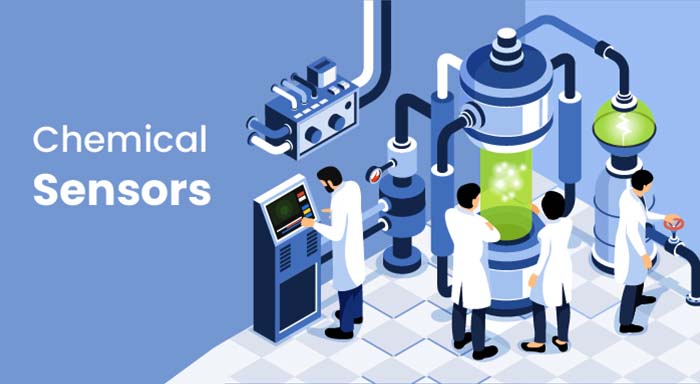Chemical sensors are key components in several industries ranging from environmental monitoring, and health care to industrial processes and homeland security. These sophisticated devices detect and measure chemical properties and changes, but they also deliver critical data that are essential for implementing exact monitoring and control.
In this blog, we’ll explore what are chemical sensors. Types and their applications. Will also discuss their advancement in the near future.
What are Chemical Sensors?
Devices that convert chemical information into an electronic signal are chemical sensors. This can be just the presence of some chemical or the concentration of some other chemical.
A chemical sensor consists of a receptor that interacts with a target analyte and a transducer for converting the interaction to a measurable signal.
Types of Chemical Sensors
1. Electrochemical Sensors:
Most of these IoT sensors operate based on the electrochemical properties of the target substance. Usually, they measure the voltage, current, or resistance change due to a chemical reaction.
Phosphorus meters and glucose sensors are common examples of such a design.
2. Optical Sensors:
The interaction of light with the target analyte is the basis for these sensors. Telegraphic detection, and its measurement, are made using changes in light absorption, fluorescence, or phosphorescence.
Due to their acceptance in environmental monitoring to detect pollutants in water and air, optical sensors are often used.
3. Mass-sensitive Sensors:
The changes in mass are measured on a sensor surface with these sensors. Quartz crystal microbalances (QCMs) are piezoelectric sensors that change their oscillation frequency in response to changes in mass on the sensor surface. It is used by the food industry for spoilage.
4. Thermal Sensors:
These sensors are temperature sensors that react to changes in temperature due to chemical reactions. The sensor measures how much heat is when a reaction happens either absorbing or releasing heat.
Combustion process and detection of exothermic chemical reactions use thermal sensors.
Application Of Chemical Sensors
Chemical sensors play a crucial role across various sectors:
Healthcare: They are also used in diagnostically important devices for measuring the body's metabolites and toxins. Blood glucose sensors, for example, are lifelines for diabetics, providing pivotal real-time monitoring.
Environmental Monitoring: Sensors measure pollutants in the air and water, helping to maintain environmental safety and regulatory compliance.
They are essential in detecting hazardous gases and pollutants like carbon monoxide and VOCs (Volatile Organic Compounds).
Industrial Processes: In manufacturing, chemical sensors ensure quality control by monitoring the presence and concentration of chemicals, preventing defects, and improving productivity.
Safety and Security: These sensors detect chemical threats and leaks, playing a crucial role in homeland security and workplace safety by providing early warnings of potential hazards.
Future of Chemical Sensors
The future of chemical sensors is bright, driven by advancements in materials science and technology. The development of nanosensors, which leverage nanotechnology, promises to improve sensitivity and selectivity, opening new possibilities for detection at lower concentrations and in more challenging environments.
Additionally, the integration of chemical sensors with the Internet of Things (IoT) will enable real-time monitoring and data analysis on a global scale, transforming industries and environmental oversight.
Conclusion
In conclusion, as technology advances, the reliance on chemical sensors will continue to grow, underscoring their importance in a technology-driven world. Their evolution and integration into various systems hold promise for enhanced safety, efficiency, and environmental stewardship.
FAQs: Chemical Sensors
1. What are the main challenges in chemical sensor development?
The primary challenges include improving selectivity to distinguish target chemicals in complex mixtures, enhancing sensitivity for detecting low concentrations, and increasing sensor stability and lifespan. Advancements in materials and nanotechnology are addressing these issues.
2. How do chemical sensors differ from biosensors?
While both detect chemical substances, biosensors specifically use biological elements (like enzymes or antibodies) as the primary sensing component. Chemical sensors don’t necessarily incorporate biological elements and can detect a broader range of chemicals.
3. What role do chemical sensors play in smart cities?
In smart cities, chemical sensors are integrated into systems for air and water quality monitoring, enhancing public health and safety. They provide data that fosters sustainable urban planning and pollution control.
4. Can chemical sensors be used in home environments?
Yes, chemical sensors are increasingly found in household devices such as carbon monoxide detectors and smart HVAC systems, where they ensure air quality and home safety.



